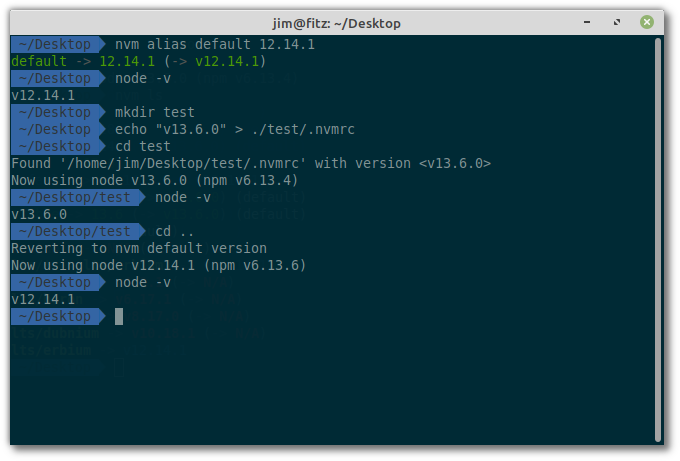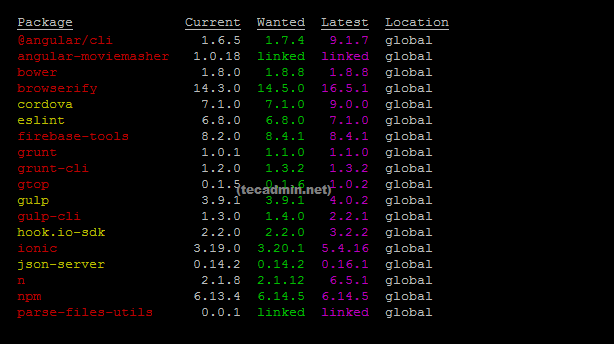

Offline_boltGetting Started The V8 JavaScript Engine Run Node.js scripts from the command line How to exit from a Node.js program How to read environment variables from Node.js How to use the Node.js REPL Node.js, accept arguments from the command line Output to the command line using Node.js Accept input from the command line in Node.js Expose functionality from a Node.js file using exports An introduction to the npm package manager Where does npm install the packages? How to use or execute a package installed using npm The package.json guide The package-lock.json file Find the installed version of an npm package Install an older version of an npm package Update all the Node.js dependencies to their latest version Semantic Versioning using npm Uninstalling npm packages npm global or local packages npm dependencies and devDependencies The npx Node.js Package Runner The Node.js Event Loop Understanding process.nextTick() Understanding setImmediate() Discover JavaScript Timers JavaScript Asynchronous Programming and Callbacks Understanding JavaScript Promises Modern Asynchronous JavaScript with Async and Await The Node.js Event emitter Build an HTTP Server Making HTTP requests with Node.js Get HTTP request body data using Node.js Working with file descriptors in Node.js Node.js file stats Node.js File Paths Reading files with Node.js Writing files with Node.js Working with folders in Node.js The Node.js fs module The Node.js path module The Node.js os module The Node.js events module The Node.js http module Node.js Buffers Node.js Streams Node.js, the difference between development and production Error handling in Node.js How to log an object in Node.js Node.js with TypeScript Node. But a custom markup information canīe provided manually, too.Offline_boltQuick Start Introduction to Node.js A brief history of Node.js How to install Node.js How much JavaScript do you need to know to use Node.js? Differences between Node.js and the Browser Method: Syntax#markup(markup: Markup): Syntax Markup information it can be also set manually. The plain text is updated when richtext() is called. Get or set the plain (output) text (the rich text after removing explicit markers and anchors). Method: Syntax#plaintext(plaintext: String): Syntax Method: Syntax#richtext(input: String): Syntax The regular expression (as a string) to recognize the closing of markings. The regular expression (as a string) to recognize the opening of markings. The regular expression (as a string) to recognize the closing of anchors. String, as Syntax internally has to assemble the regular expressions. Remember to extra-escape the special characters and to pass this as a The regular expression (as a string) to recognize the opening of anchors. The string newlines ( \r?\n) are replaced to in the output. The string TAB characters are replaced to in the output. The XML tag prefix used in the XML output. The CSS class prefix used in the HTML output. Just markings and anchors are recognized). Highlighting of comments, keywords and literals at all (then The available configuration options are:Ĭontrol the syntax highlighting of comments, keywords and literals.īy default, the language is guessed. Method: Syntax#config(config?: Object): Syntax Import Syntax from "syntax" let syntax = new Syntax ( : Installation Node environments (with NPM package manager): Syntax supports this by internally using such an offsetīased markup information and also exposing it in the API for external In Microsoft Team Foundation Server (TFS) 2018 and previous versions, build and release pipelines are called definitions, runs are called builds, service connections are called. This task no longer takes new features and only critical bugs are addressed. Precise offset information for anchors, markings, comments, keywordsĪnd literals. The npm Authenticate task is the recommended way to authenticate with Azure Artifacts. One also wants to support other formats and for this one needs the Usually, having HTML or XML output format is sufficient, but sometimes

Text (by removing markings and anchors) and reapplying the markings Resolves this problem by first reducing the (rich) input text to plain
#Npm install package with version syntax code
Unfortunately, whatever syntax is used for marking and anchors, thisĪlways conflicts with the language-dependent syntax highlightingĪs the marking and anchors renders the source code invalid. In technical documentation it is regularily necessary to markĪrbitrary pieces of code and interspice reference anchors. These three kinds of syntactical elements. As aĬonsequence, Syntax intentionally(!) reduces the syntax highlighting Hence should highlight comments, keywords, and literals only. That syntax highlighting has to be as unobstrusive as possible and Strict opinion when it comes to source code. Engelschall, is a die-hard coder with a very Is a science of its own, Syntax under the hood uses the excellent

The language-specific determination of comments, keywords and Syntax is based on four major design aspects: Syntax is JavaScript library (for use in Node.js and BrowserĮnvironments) to apply Syntax Highlighting to a piece of input text.


 0 kommentar(er)
0 kommentar(er)
